Hurricane eMatrix
List of Activity Sheets » Community support and public health services
Locating, Collecting, and Housing Stray Animals
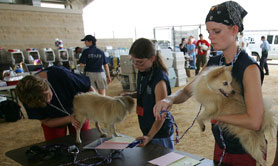
This picture shows actual disaster site work conditions and may not illustrate proper safety and health procedures.
Activity Description
- This activity sheet lists hazards to properly trained animal handlers who are collecting and temporarily housing wild and domestic stray animals.
- For some operations or situations (e.g., confined space entry) other activity sheets also apply; see related activity sheets below.
- As a result of Hurricanes Katrina and Rita (2005), the American Society for the Prevention of Cruelty to Animals estimates that over 8,000 dogs, cats, horses, livestock, and other wild and exotic animals have been rescued in Mississippi and Louisiana. Before they are rescued, these animals may be frightened, malnourished, injured, or diseased. Because of their condition, they may not react predictably.
- Wild and stray animals should only be recovered, housed, or cared for by their owners or properly trained animal handlers, such as animal control officers or game wardens. Members of the general public as well as individuals conducting disaster-related activities who identify a wild or stray animal that needs to be recovered and cared for should call the local animal control officer. Alternatively, response and recovery workers should report the animal to the incident management staff through their supervisor.
- Response and recovery workers conducting this operation may be employed by Federal, State, local, and private employers. Review How to Use This Matrix in the introduction for a discussion of how this information may apply to different workers.
About the Activity Sheet
This activity sheet does not provide an in-depth analysis of OSHA standards and regulations and cannot address all hazards. It does not increase or diminish any OSHA requirement or employer obligation under those requirements. It is intended as a guide and quick reference for employers and response and recovery workers. The Matrix captures major activities involved in hurricane response and recovery, highlights many of the hazards associated with them, and recommends beneficial work practices, personal protective equipment (PPE), and other exposure control methods. Employers must evaluate the specific hazards associated with the job/operation at the site where the work is being performed.
Employers are responsible for providing a safe and healthful workplace for their workers. OSHA's role is to assure the safety and health of America's workers by setting and enforcing standards; providing training, outreach, and education; establishing partnerships; and encouraging continual improvement in workplace safety and health.
The Hazard Exposure and Risk Assessment Matrix for Hurricane Response and Recovery Work provides a general overview of particular topics related to current OSHA standards. It does not alter or determine compliance responsibilities in OSHA standards or the Occupational Safety and Health Act of 1970, or the equivalent State Plan standards and requirements. Because interpretations and enforcement policy may change over time, you should consult current OSHA/State Plan administrative interpretations and decisions by the Occupational Safety and Health Review Commission and the courts for additional guidance on OSHA compliance requirements. Employers should modify their procedures as appropriate when additional, relevant information becomes available.
General Recommendations
Key Engineering Controls and Work Practices. See general recommendations document.
Personal Protective Equipment. The general PPE is recommended for all response/recovery tasks/operations; only the additional PPE that may be needed for a specific hazard is noted below.
General PPE includes:
- Hard hat for overhead impact or electrical hazards
- Eye protection with side shields
- Gloves chosen for job hazards expected (e.g., heavy-duty leather work gloves for handling debris with sharp edges and/or chemical protective gloves appropriate for chemicals potentially contacted)
- ANSI-approved protective footwear
- Respiratory protection as necessary—N, R, or P95, filtering facepieces may be used for nuisance dusts (e.g., dried mud, dirt and silt) and mold (except mold remediation). Filters with a charcoal layer may be used for odors
Recommendations Specific to Hazards Associated with Locating, Collecting, and Housing Stray Animals
Key Engineering Controls and Work Practices
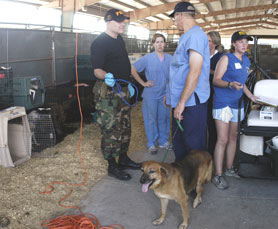
- Be on guard for wild or stray animals as they exhibit unpredictable or aggressive behavior
- Inspect areas for nests and wild animals
- Assume that all snakes are poisonous and that all animals are rabid
- Select and use capture, housing, and handling equipment (e.g., traps, cages, rabies poles, tranquilizer darts) based on the animal and environment
- Seek immediate medical attention for bite wounds; report bite wounds to your supervisor
- Use insect repellent containing DEET or Picaridin on exposed skin and wear a long-sleeved shirt and pants
Additional Personal Protective Equipment
- Protective bite-proof body armor including face shields and gloves
Key Engineering Controls and Work Practices
- If possible, coax any known wild or stray animals out of a structure
- Conduct an initial search for wild or stray animals from outside damaged structures to the extent feasible
- Limit access/set up controlled access zones until stability and structural integrity is known
- Ensure that a competent person inspects building and floors before entry to perform work. A competent person is able to recognize existing and predictable hazardous conditions and has the authority to take prompt corrective measures to eliminate the hazardous conditions
- Install temporary structural support (shoring, bracing) adequate to protect workers
Key Engineering Controls and Work Practices
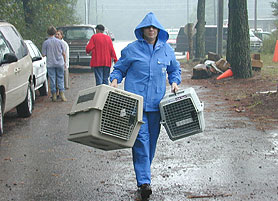
- Assume that electrical lines are energized until proven otherwise. Lines and other conductors may become reenergized without warning as utilities are evaluated and restored after a disaster
- Inspect the work area for downed conductors and do not go near, drive over, or otherwise come in contact with them
- Downed electrical conductors can energize other objects, including fences, water pipes, bushes, trees, and telephone/CATV/fiber optic cables
- Unless deenergized and visibly grounded, maintain proper distance from overhead electrical power lines (at least 10 feet) and/or provide insulating barriers
- Do not approach any gas leaks; if a gas leak is detected, secure spark-producing devices (e.g., engines, tools, electronic, and communications equipment) and evacuate the area until the leak is secured
- Contact utility company to assist in locating, marking, and shutting off/purging utility lines that may pose a hazard or may be impacted; ensure that lines have been purged as needed before beginning work
Key Engineering Controls and Work Practices
- Confined spaces have limited means of entry or exit, are large enough to bodily enter, and may contain physical (e.g., mechanical, electrical, hydraulic, pneumatic energy; engulfment hazards; inwardly converging surfaces) or atmospheric hazards (e.g., atmospheres that are oxygen-deficient or oxygen-enriched, contain or may contain flammable gas, vapor or mist, airborne combustible dust, toxic substances, or any other atmosphere that is immediately dangerous to life or health). Examples include storage tanks, process vessels, bins, boilers, vaults, ventilation or exhaust ducts, sewers, tunnels, pipelines, and pits more than 4 feet in depth
- Hurricane-related events might introduce hazards or potential hazards into confined spaces. For example, a space might have a potential to contain a hazardous atmosphere due to the presence of decomposing organic matter, to the use of hazardous chemicals in the space, or to the performance of operations in the space, such as welding, cutting, or burning, that may create a hazardous atmosphere. Additional precautions must be taken to make the space safe for entry
- Evaluate the need for entry (i.e., placing any body part into the space)
- If entry is required, see Entry into Confined Spaces activity sheet
Key Engineering Controls and Work Practices
- Inspect ladders for cracked, broken, or defective parts before use
- Do not exceed the load rating of ladders—remember that load ratings include people, tools, and equipment
- Set up ladders on stable surfaces
- Set extension or straight ladders at a 75 degree angle from the ground (1/4 foot back for every foot of rise) and provide 3 feet above an upper landing surface to ease climbing onto/descending from height
- Use non-conductive ladders (e.g., fiberglass) and exercise extreme caution when working near power lines
- Secure ladders that can be displaced by work activities; consider barricades at the base to keep traffic away
Key Engineering Controls and Work Practices
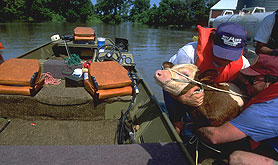
- Wash skin or clothing that comes in contact with biological materials (e.g., blood, feces) from an animal
- Change clothes if they come in contact with an animal that appears contaminated with hazardous or unknown materials
- Wash hands every time gloves are removed
- Report injuries and exposures to body fluid to supervisor
Additional Personal Protective Equipment
- In addition to work gloves, inner chemical protective glove
Key Engineering Controls and Work Practices
- Take extra care when stepping into areas that are unstable/uneven or where the surface cannot be seen
- See general recommendations document
Key Engineering Controls and Work Practices
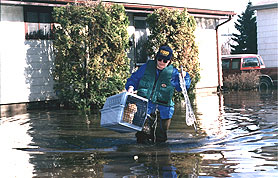
- Reduce the exposure to splash or aerosolized liquid hazards by limiting the number of people in the area and having those in the area stay upwind of water discharge areas
- Ensure that good hygiene, especially hand washing, is practiced before eating, drinking, and smoking. If clean water is not available, use an alternative such as hand sanitizer or sanitizing wipes
- Ensure that cuts and bruises are protected from contact with contaminated water
- Clean areas of the body that come in contact with contaminated water with soap and water, hand sanitizer, or sanitizing wipes
Additional Personal Protective Equipment
- Goggles if routinely working near splashing floodwater
- N, R, or P95 respirators may be necessary for exposure to contaminated water that may become aerosolized
- Watertight boots with steel toe and insoles
- Waterproof gloves for contact with contaminated water
Key Engineering Controls and Work Practices
- Use additional protections, such as a lifesaving skiff and a ring buoy as appropriate
Additional Personal Protective Equipment
- All personnel should wear Coast Guard-approved Type I or II personal floatation devices
- Watertight boots with steel toe and insole
Key Engineering Controls and Work Practices
- See Work Zone Safety and Traffic Control within a Work Area activity sheet
Additional Personal Protective Equipment
- ANSI/ISEA 107-2004 compliant high visibility safety apparel and headwear
Key Engineering Controls and Work Practices
- If hazardous chemical containers are found or leaking materials are detected:
- Do not use spark-producing devices (e.g., engines, tools, electronic, and communications equipment) in the immediate area
- Take self-protective measures (i.e., move to a safe distance upwind) and contact hazardous material response personnel for evaluation/removal before continuing work in the area
Additional Personal Protective Equipment
- Evaluate the need to revise protective clothing, respirator, and glove selection
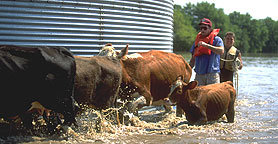
Select any of the following potential hazards that can be associated with this activity in order to access relevant recommendations in the general recommendations document:
- Cuts and Lacerations
- Manual Handling of Materials/Weight
- Environmental hazards
Additional Medical Needs
- Follow medical guidance and precautions outlined in the general recommendations document
- For trained animal handlers, completion of a three-dose prophylactic vaccination series for rabies
Additional Training Needs
- Follow general site- and task-specific training guidelines as outlined in the general recommendations document
- Previous training in proper animal restraint and capture
Related Activity Sheets
- Removal of Floodwaters from Buildings and Initial Entry into Previously Flooded Building Areas
- Search and Rescue
- Removing Human and Animal Remains
- Entry into Confined Spaces
- Work Zone Safety and Traffic Control within a Work Area
Other Resources and References
- Animal Disposal Following an Emergency. Centers for Disease Control and Prevention, (CDC).
- Sawmills. OSHA eTool

